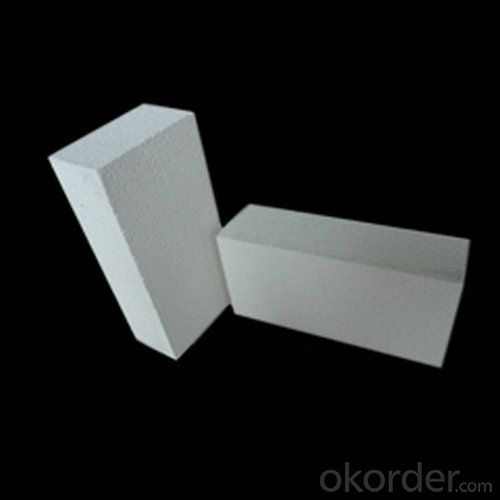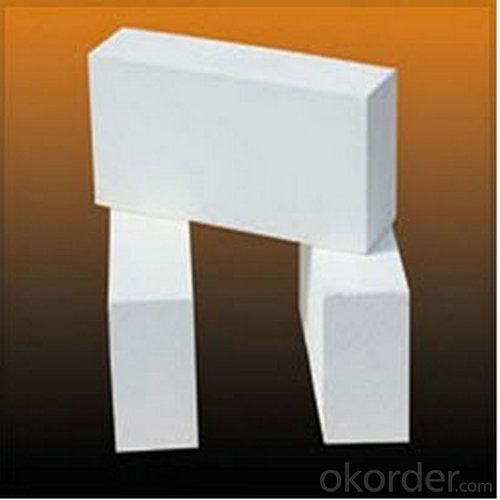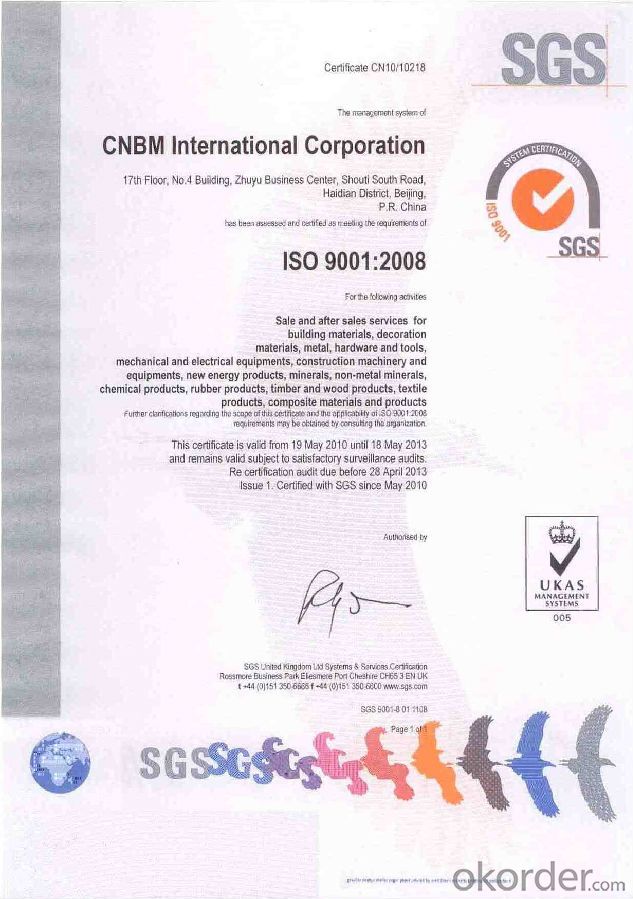Insulating Firebricks GJM23 for hHot Face Lining
- Loading Port:
- Tianjin
- Payment Terms:
- TT OR LC
- Min Order Qty:
- 1 m.t.
- Supply Capability:
- 20000 m.t./month
OKorder Service Pledge
OKorder Financial Service
You Might Also Like
General Information of Insulating Firebricks
CMAX insulating firebricks are classified under temperature between 1300℃ to 1700℃, manufactured from high purity alumina clay.
Feature of Insulating Firebricks
Light weight and low thermal conductivity
Low heat storage
Low iron and impurities
High thermal shock resistance
Application of Insulating Firebricks
CMAX insulating firebricks can be used as a hot face lining directly exposed to the heat or as a backup insulation layer in iron and steel mills, non-ferrous foundries, petrochemical, ceramic, glass.
Images of Insulating Firebricks


Technical Data of Insulating Firebricks
INSULATING FIRE BRICK---GJM23
Classification Temperature (℉/℃) 2300/1260
Bulk Density (g/cm3) ≤0.5
Thermal Conductivity
800℃, W/m.K ≤0.18
1000℃, W/m.K ≤0.20
Reheating Linear Change (%) 1230℃×12h
≤0.5
Chemical Composition (%)
Al2O3 ≥45
Fe2O3 ≤1.0
Company Introduction
Who CNBM is
CNBM is a Fortune 500 and a governmental owned National Building Material company in Beijing, China.
What CNBM Can Do
We can supply ALL KINDS OF REFRACTORIES BRICK/CASTABLE and CERAMIC FIBER PRODUCTS in high quality and competitive price.
What Certification CNBM Have

FAQ
If I need your offer, what information do you need?
In order to choose suitable products, it will be appreciated to provide us the information, such us specification, technical data, order quantity, products application etc.
If any question, please contact us freely.
How do you control the products quality?
With strict quality control system throughout the materials selection and production process, our refractory and ceramic fiber products quality is effectively controlled to meet customer requirements.
From the raw materials selecting, our quality control begin. The quality certificates of raw materials are required and each batch will be tested before using. During production, the quality control are conducted by workers and then each piece will be sorted and examined by quality supervisor.
I’m not satisfied with the refractory materials I used before, can you propose more suitable pro
Yes. Please give us the problems you faced, your requirements and the technical data of the products you used before. That we will give you our suggestion and propose the solution based on your special requirements.
What’s the lead time for my order?
It depends on customers’ requirements and our production schedule. And usually we need 30-60 days for refractory bricks,10-25 days for unshaped refractory materials and 10-20 days for ceramic fiber blankets.
Can you offer Door-to-Door delivery?
Yes, but only for some countries such us U.S., UAE, Saudi Arabia, Iran, and Russia, etc.
What is the minimum quantity?
There is no minimum order quantity. Depending on the item and processing, there may be a minimum production required, however we can offer a quotation based only on the quantity you need.
- Q:How are insulating fire bricks installed?
- Insulating fire bricks are typically installed by stacking them in a pattern, using a special refractory mortar or adhesive to secure them together. The bricks are carefully aligned and leveled to create a solid and heat-resistant barrier. It is important to follow the manufacturer's instructions and ensure proper curing time for the mortar before exposing the bricks to high temperatures.
- Q:Can insulating fire bricks be used in the construction of industrial boilers?
- Industrial boilers can utilize insulating fire bricks for their construction. These bricks are specially designed with low thermal conductivity, making them ideal for retaining heat in high-temperature applications. In the case of industrial boilers, insulating fire bricks can be used to line the combustion chamber and other areas that require insulation. The use of insulating fire bricks in industrial boilers offers several advantages. Firstly, their low thermal conductivity helps reduce heat loss, thereby improving the overall energy efficiency of the boiler. This can lead to significant cost savings in the long run. Additionally, these bricks have a high resistance to thermal shock, making them capable of withstanding frequent temperature fluctuations without cracking or breaking. This is particularly important in boiler applications where temperatures can change rapidly. Moreover, insulating fire bricks are lightweight and easy to install, making them a convenient choice for construction projects. They can be shaped and cut to fit the specific requirements of the boiler, allowing for a precise and efficient installation process. In summary, the use of insulating fire bricks in the construction of industrial boilers is a suitable choice due to their excellent thermal insulation properties, resistance to thermal shock, and ease of installation.
- Q:Are insulating fire bricks resistant to insect infestations?
- Insulating fire bricks are primarily designed to provide high thermal resistance and are not specifically designed to resist insect infestations. However, due to their dense and solid structure, insulating fire bricks can provide a physical barrier to insects, making it difficult for them to penetrate or burrow into the bricks. Additionally, the high temperatures that insulating fire bricks can withstand may deter insects from nesting or infesting them. However, it is important to note that no material is completely impervious to insect infestations, and if there are cracks or gaps in the bricks, insects may still find their way in. Regular inspection and maintenance are necessary to ensure the integrity of the bricks and prevent any potential insect infestations.
- Q:Can insulating fire bricks be used in the construction of smelters or foundries?
- Yes, insulating fire bricks can be used in the construction of smelters or foundries. Insulating fire bricks have excellent thermal insulation properties and can withstand high temperatures, making them suitable for lining the walls and floors of smelters or foundries. They help to retain heat, improve energy efficiency, and protect the surrounding structures from extreme temperatures.
- Q:Is it necessary to use mortar when installing insulating fire bricks?
- Using mortar during the installation of insulating fire bricks is necessary. It plays a crucial role in bonding the bricks together, guaranteeing a tight and secure fit. Moreover, it contributes to the creation of a sturdy and long-lasting structure capable of enduring high temperatures. Should mortar be absent, the bricks might not be adequately secured and could shift or loosen, thereby compromising the integrity of the installation. Additionally, mortar serves to fill any gaps or spaces between the bricks, providing insulation and preventing heat loss. Consequently, employing mortar is indispensable for a prosperous and efficient installation of insulating fire bricks.
- Q:Can insulating fire bricks be used in high-temperature insulation for aerospace applications?
- Yes, insulating fire bricks can be used in high-temperature insulation for aerospace applications. These bricks are designed to withstand extremely high temperatures and provide excellent insulation properties, making them suitable for use in aerospace applications where thermal protection is crucial.
- Q:Can insulating fire bricks be used for insulation in aluminum smelters?
- Yes, insulating fire bricks can be used for insulation in aluminum smelters. Insulating fire bricks are designed to withstand high temperatures and provide excellent thermal insulation, making them suitable for use in aluminum smelters where extreme heat is generated.
- Q:Can insulating fire bricks be used for insulation in flues?
- Insulating fire bricks are specifically designed for high-temperature applications and are commonly used in furnaces, kilns, and other industrial settings. While they are excellent for insulating heat and preventing heat loss in these environments, they are not recommended for use in flues. Flues are subjected to extreme temperatures, corrosive gases, and the potential for soot and creosote buildup. Insulating fire bricks are not designed to withstand these conditions and may deteriorate or crack over time when exposed to the acidic and corrosive gases produced by combustion. For insulation in flues, it is best to use materials that are specifically made for this purpose, such as refractory cement or ceramic fiber insulation. These materials are more resistant to the harsh conditions found in flues and are better suited to provide effective insulation while ensuring the safety and durability of the flue system.
- Q:What are the key properties of insulating fire bricks?
- IFBs, also known as insulating fire bricks, exhibit numerous essential characteristics that greatly enhance their effectiveness in various industrial applications. To begin with, insulating fire bricks possess a remarkable capacity for thermal insulation. This means that they can endure exceedingly high temperatures while minimizing the transfer of heat. By retaining heat within the desired area, this insulation property prevents heat loss and improves overall energy efficiency. Moreover, insulating fire bricks exhibit exceptional refractory properties. Refractoriness denotes a material's ability to endure high temperatures without deforming or deteriorating. IFBs are specifically engineered to possess a high refractory rating, enabling them to withstand temperatures up to 3000°F (1650°C) without succumbing to thermal shock or degradation. An additional key property of insulating fire bricks is their low thermal conductivity. This characteristic ensures that heat is not easily conducted through the bricks, resulting in reduced heat loss and increased energy conservation. The low thermal conductivity of IFBs also permits rapid heating and cooling cycles, rendering them ideal for applications requiring swift temperature changes. Furthermore, insulating fire bricks are lightweight and boast a remarkable strength-to-weight ratio. This facilitates easy handling, transportation, and installation, thereby reducing labor and logistical expenses. Despite their lightweight nature, IFBs retain structural integrity and provide dependable insulation. Lastly, insulating fire bricks exhibit high resistance to chemical attack and corrosion, guaranteeing their durability and longevity even in harsh environments. They are commonly employed in applications involving acids, alkalis, and other corrosive substances, offering reliable insulation and protection. To summarize, the key properties of insulating fire bricks encompass high thermal insulation, excellent refractory properties, low thermal conductivity, a lightweight yet strong structure, and resistance to chemical attack. These properties render IFBs highly sought after for a vast array of industrial applications, including furnaces, kilns, incinerators, and other high-temperature settings.
- Q:Can insulating fire bricks be used in the construction of hot water boilers?
- Yes, insulating fire bricks can be used in the construction of hot water boilers. These bricks are designed to withstand high temperatures and provide excellent insulation, making them suitable for applications such as hot water boilers where heat retention is crucial.
1. Manufacturer Overview |
|
|---|---|
| Location | |
| Year Established | |
| Annual Output Value | |
| Main Markets | |
| Company Certifications | |
2. Manufacturer Certificates |
|
|---|---|
| a) Certification Name | |
| Range | |
| Reference | |
| Validity Period | |
3. Manufacturer Capability |
|
|---|---|
| a)Trade Capacity | |
| Nearest Port | |
| Export Percentage | |
| No.of Employees in Trade Department | |
| Language Spoken: | |
| b)Factory Information | |
| Factory Size: | |
| No. of Production Lines | |
| Contract Manufacturing | |
| Product Price Range | |
Send your message to us
Insulating Firebricks GJM23 for hHot Face Lining
- Loading Port:
- Tianjin
- Payment Terms:
- TT OR LC
- Min Order Qty:
- 1 m.t.
- Supply Capability:
- 20000 m.t./month
OKorder Service Pledge
OKorder Financial Service
Similar products
New products
Hot products
Related keywords





























